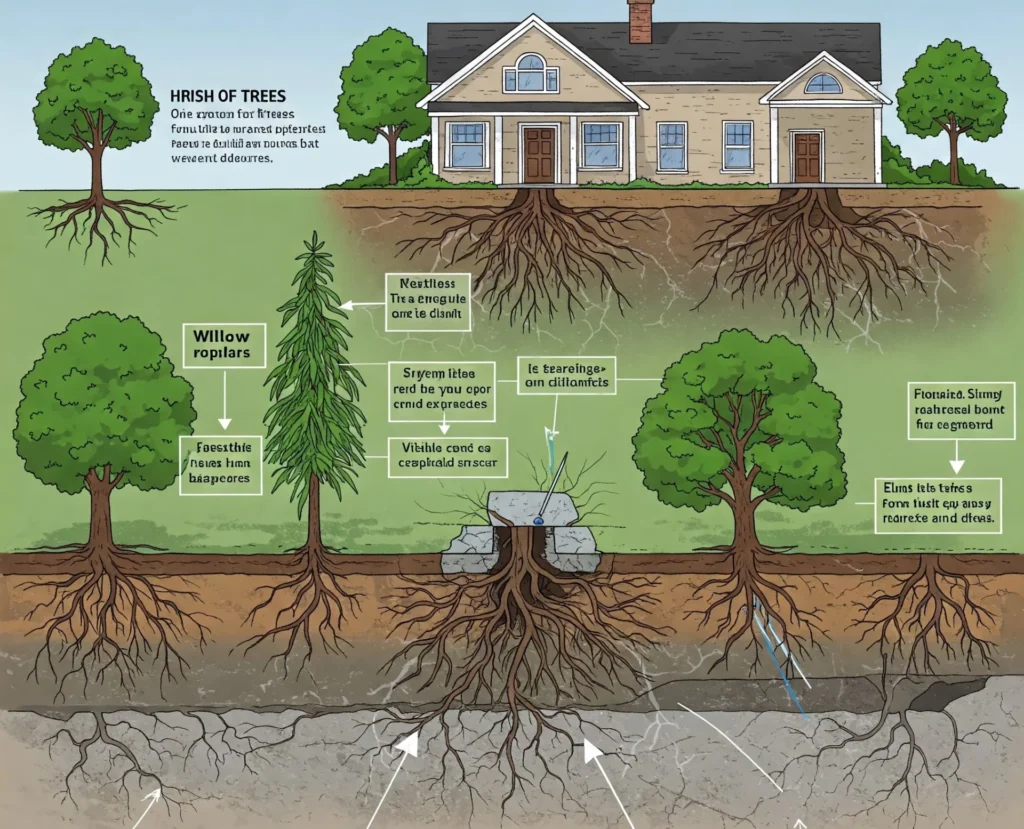Trees are a beautiful and worthwhile addition to any landscape and provide shade, clean air, and curb appeal. However, their roots can be detrimental to your home’s foundation unless you take special care. In this blog post, we will talk about how trees can impact your foundation and what you can do to prevent causing damage.
Table of Contents
ToggleYou might like: Foundation Repair Cost Guide: Average Prices & Saving Tips
How Tree Roots Affect Your Home’s Foundation
Tree roots naturally seek out moisture and since soil around your foundation is prone to holding water, it is a target. Some of the impacts tree roots can cause to your home are:
Soil Shrinkage – Large trees extract large amounts of water from the soil and cause it to shrink. This can lead to settlement and foundation cracking.
Soil Expansion and Heaving – Tree roots expand soil in some soils, especially clay soils. This puts pressure on your foundation and can cause it to crack and become unstable.
Root Intrusion – Roots can grow into small cracks in your foundation and exacerbate existing conditions.
Uneven Moisture Distribution – If there is more moisture loss on one side of your home through tree roots, it can cause differential settling and lead to structural problems.
Types of Trees That Pose the Highest Risk to Foundations
There are certain tree species with very invasive root systems that can put your home foundation in danger. Some of them are:
Willows (Weeping Willow, Black Willow, and White Willow) – They have large root systems that seek water and can intrude on foundations and drainage systems.
Poplars (Lombardy Poplar, White Poplar, and Black Poplar) – Poplars are thirsty and grow quickly and tend to spread out extensively and deeply through roots, making them a hazard for homes.
Oaks (Red Oak, Pin Oak, and Live Oak) – While oaks are beautiful and long-lived trees themselves, they do tend to grow expansive roots that cause soil movements near foundations.
Silver Maple – Silver maples tend to grow rapidly and possess shallow and invasive roots that can cause significant structural damage.
Elms (American Elm and Chinese Elm) – Elms form large and robust root systems that can interfere with foundations, walkways, and buried utilities.
If you do happen to have any of these trees near your home, it is advisable to take precautions to protect your foundation.
Signs of Tree-Related Foundation Damage
If you suspect that a tree is undermining your foundation, look for these warning signs:
Cracks in walls, floors, or ceilings
Uneven or sloping floors
Doors and windows sticking or not closing properly
Visible gaps between walls and floors
Outside foundation cracks
How to Prevent Tree Damage to Your Foundation
While trees are beneficial in many ways, precautions should be taken to protect your home foundation. Here are some helpful steps:
Choose the Right Trees –Choose trees that do not produce invasive roots, such as dogwoods or redbuds, and plant them on your property away from your home.
Proper Tree Placement – A rule of thumb is to plant trees no closer than they will be when mature. So for a tree that will grow to be 30 feet, plant it no closer than 30 feet to your house.
Install Root Barriers – A root barrier can redirect tree roots away from your foundation and reduce the likelihood of damage.
Maintain Consistent Soil Moisture – Use soaker hoses or irrigation systems to prevent soil shrinking and expansion.
Regular Inspections – Keep your landscape and foundation under surveillance. If you notice warning signals beforehand, seek advice from a specialist.
Tree Removal or Relocation Options
If a tree is posing a serious threat to your foundation, you may need to consider removal or relocation. Here are some options:
Professional Tree Removal – If a tree is too close to your foundation and is causing structural damage to it, getting a tree removal by a professional arborist is your best option.
Transplanting the Tree – If your tree is worth it and still of a manageable size, a tree relocation specialist can move it to a safe distance away from your home.
Gradual Root Pruning –In some circumstances, careful root trimming gradually can control development without cutting down the entire tree.
Stump Grinding and Root Treatment – Once you’ve removed the tree, you should grind out the stump and treat the roots to keep them from regrowing and causing continued problems with your foundation.
It is best to seek advice from a tree specialist to determine what is best for your specific situation.
Hiring a Professional Arborist for Tree Assessment and Maintenance
An experienced arborist can play a crucial role in ensuring that trees near your home are not creating foundation issues. Here’s how:
Tree Health Evaluation – Arborists are able to identify your trees’ health and identify potential threats before they become significant problems.
Root System Analysis – Through root development patterns, it is possible for an arborist to identify whether a tree’s roots might be intruding on your foundation.
Pruning and Maintenance – Proper tree pruning can manage root development and keep trees healthy and strong, minimizing the potential for foundation damage.
Tree Relocation or Removal Advice – If your tree is too close to your home, you can consult with an arborist on whether it is to be relocated or removed.
Preventive Care Plans – Ongoing care and maintenance plans by a certified arborist can keep your trees healthy and your foundation safe.
Insurance Considerations for Tree-Related Foundation Issues
When tree roots damage your home’s foundation, there is a gray area with insurance coverage. Here is what you should know:
Homeowner’s Insurance Coverage – Homeowner’s policies typically do not cover tree root foundation damage as it is considered a maintenance issue and not sudden damage.
Exceptions – If your tree falls as a result of a storm or other covered cause and damages your foundation, your policy can pay for repairs.
Additional coverage for foundation repairs – Some firms offer supplemental coverage for foundation repairs and it is worth asking your provider.
Prevention is better – Insurance companies can decline claims in the event that it is discovered that harm could have been prevented through normal tree maintenance.
Consult Your Insurance Agent – If you are not sure about your coverage, you can contact your insurance company to ask about policy provisions and exclusions for tree root damage.
Tree-Related Foundation Issues in Houston: Insights and Statistics
| Factor | Statistic |
|---|---|
| Percentage of foundation issues caused by trees | 40% |
| Average cost of tree-related foundation repair | $4,500 – $12,000 |
| Most common problematic trees in Houston | Oak, Silver Maple, Elm, and Willow |
| Average tree removal cost | $500 – $3,000 |
| Average distance recommended for planting trees from home | 20 – 50 feet |
| Home insurance policies covering tree-related damage | Less than 30% |
Conclusion and Final Thoughts on Maintaining a Healthy Foundation Around Trees
Trees and foundations can co-exist with careful planning and maintenance. Consider these key points:
Choose tree species with non-invasive roots to reduce the risk of foundation damage.
Plant trees at a safe distance from your home to prevent root intrusion.
Use root barriers and consistent soil moisture management to maintain foundation stability.
Regularly inspect trees and foundations for signs of damage or instability.
Consult with a professional arborist for guidance on tree care and maintenance.
By being proactive, you can enjoy the benefits of trees while protecting your home’s structural integrity.
For expert foundation solutions, contact R.L. NELSON Foundation Solutions at 281-420-1739.






